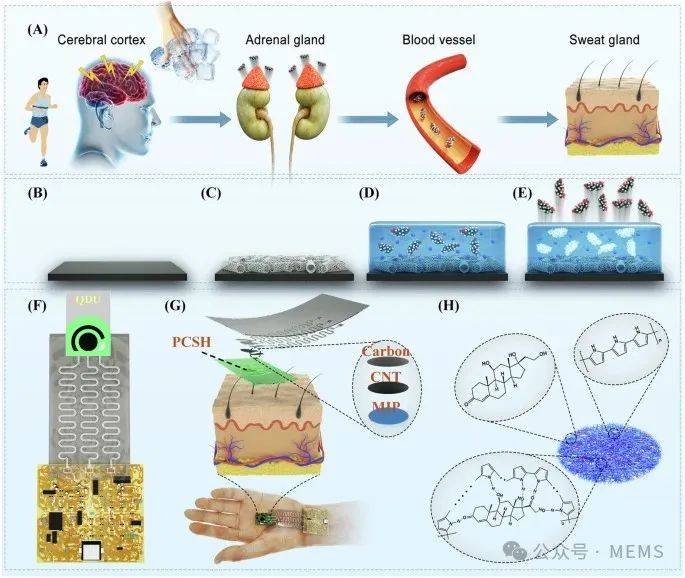Our bodies need to experience stress in order to adapt to the constantly changing environment. However, prolonged psychological stress can lead to various mental disorders, including depression, anxiety, and post-traumatic stress disorder. Excessive stress can also severely impact individual health and may result in long-term immune dysfunction. Cortisol, a stress hormone present in the human body, reflects psychological stress and health conditions in daily life, serving as a potential biomarker for stress responses in the body.
According to reports from Maims Consulting, researchers from the Suzhou Institute of Biomedical Engineering and Technology of the Chinese Academy of Sciences and Qingdao University have recently developed a flexible wearable cortisol detection sensor with excellent reliability and sensitivity to effectively collect sweat and accurately identify biomarkers. Molecularly imprinted polymers (MIP) ensure the specificity of cortisol. Carbon nanotubes (CNT) on the electrode enhance sensitivity, broadening the detection range to 10⁻³ to 10⁴ nM, with a sensitivity of 189.2 nA/lg(nM). In addition, the porous chitosan hydrogel (PCSH) can effectively collect sweat, providing a low-cost alternative for microfluidic technology with its adhesive properties and 80% swelling rate. Flexible printed circuit boards (FPCB) and serpentine electrodes (SE) ensure the durability of the sensor. This non-invasive, highly sensitive sensor offers a new method for monitoring mental stress and clinical diagnosis, advancing the development of physiological state monitoring in humans. The related research findings were published in the journal npj Flexible Electronics under the title “High-precision flexible sweat self-collection sensor for mental stress evaluation”.
Schematic diagram of the integrated wearable sweat sensor patch for mental stress analysis
MIP combines cortisol with pyrrole (Py) to form a highly specific cavity structure that simulates the interaction between natural receptors and ligands. Compared to other sensor technologies, the manufacturing process of MIP sensors typically does not require complex synthetic steps or expensive materials, thus possessing broad application potential. In order to improve the detection efficiency of cortisol in sweat, researchers deposited CNT on the substrate of MIP to enhance its specific surface area.
Verification of the binding of cortisol to the electrode
During the circadian cycle, cortisol levels typically peak in the morning and then gradually decline, reaching their lowest point in the evening. Under the stimulation of acute physical activity, cortisol levels tend to temporarily rise. During exercise or cold press tests (CPT), the body releases cortisol to regulate metabolism and energy expenditure, with cortisol content in sweat rising to about 250 nM when subjected to external stimulation.
Actual testing with volunteer participation
To meet personalized mental health needs, researchers designed a wearable sensor for psychological stress consisting of FPCB and SE. To better adapt to the human body, the sensing electrode employs an SE design, offering improved scalability and flexibility. Experimental results indicate that this flexible wearable sensor has high sensitivity and specificity, effectively detecting cortisol levels in sweat. Additionally, sample processing is simple, and the detection process is quick and convenient.


